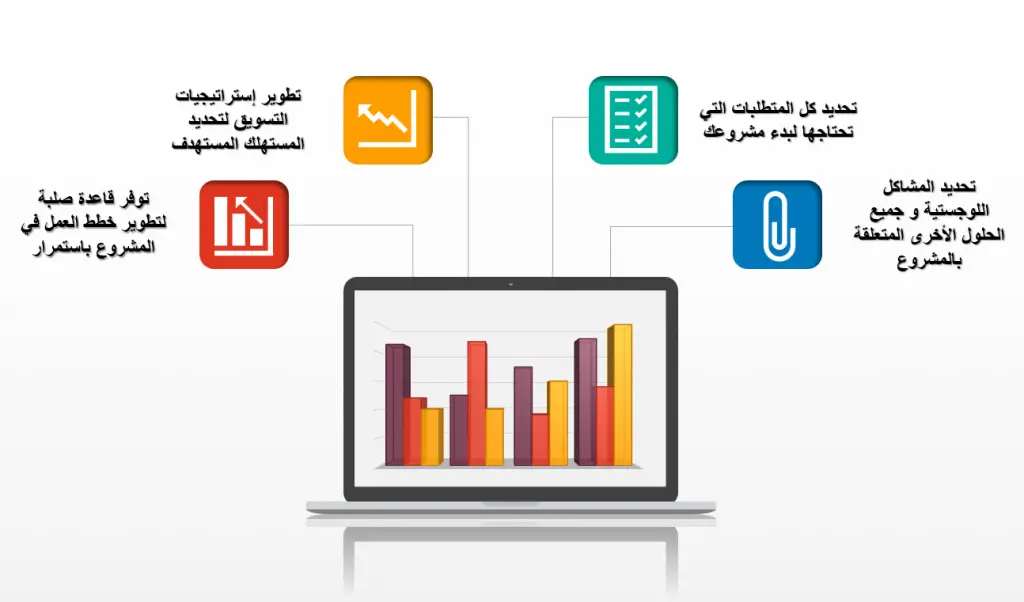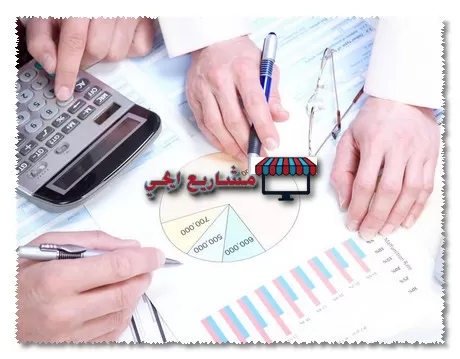Feasibility study of a distribution project
The Feasibility Study of the Distribution Project presents a viable opportunity for businessmen wishing to start their own projects in the field of celebrations and events.
This project aims to provide innovative and attractive distributions for births and marriages.
By following these steps, those wishing to start a distribution business can gain the necessary knowledge on how to purchase antiques and distributions from trusted suppliers.
In addition, they can purchase suitable stands to display these distributions in an attractive and beautiful way.
The feasibility study for the Distribution project is characterized by being an idea that is easy to implement and operate, and allows people who prefer to work from home to make profits from selling their products online.
Thanks to social media and e-commerce sites, the business can reach a wide range of potential customers.
In addition, many ready-made reports and studies are available that help businessmen analyze the feasibility of the project and estimate the required investment and expected profits in the short and long term.
These reports include valuable information and ready-made templates suitable for various types of projects.

What are the types of feasibility study?
- Environmental feasibility studies:
This study is concerned with evaluating the potential environmental impacts of the proposed project.
The impacts on land, water resources and the natural environment are analyzed, with the aim of ensuring that the project is implemented in a sustainable manner and in compliance with environmental laws. - Legal feasibility studies:
This study focuses on evaluating aspects of law and legislation related to the project.
Includes an analysis of required permits, licenses, and national and local laws related to the project.
This analysis is intended to ensure compliance with laws and avoid potential legal problems in the future. - Marketing feasibility studies:
This study is concerned with analyzing the market, consumer needs, and potential competition.
This analysis aims to determine the chances of success of the project and determine an appropriate marketing strategy to attract customers. - Technical feasibility studies:
This study includes evaluating the feasibility of implementing the project from a technical standpoint.
The required equipment, human resources and experience required to successfully implement the project are analysed.
This analysis aims to determine the technical feasibility of implementing the project. - Financial feasibility studies:
This study is concerned with the financial analysis of the proposed project.
This includes estimating the costs, expected revenues, and potential profits of the project in the short and long term.
This analysis aims to determine the financial feasibility of the project and evaluate its investments. - Social feasibility studies:
This study focuses on analyzing the potential social impacts of the project.
Impacts on the local community, culture, employment and economic development are assessed, with the aim of determining the project's sustainability and positive social impact.
What are the characteristics of a feasibility study?
1- Concern about the future: The feasibility study seeks to evaluate investment ideas that may last for a long time.
Therefore, the importance of the feasibility study lies in achieving the maximum benefit from the project.
2- Assistance in decision making: The feasibility study helps in analyzing all factors related to the project, such as economic, technical, legal, and scheduling factors.
Thus, it helps in choosing the available investment opportunities in a correct and clear way.
3- Determining the validity of the investment idea: The feasibility study aims to determine the validity of the investment idea for the project.
Thus, a decision can be made to start the project or avoid it if the investment idea turns out to be unsuccessful.
4- Providing technical and economic information: The feasibility study also provides technical, economic, operational, legal, temporal and technological information for the project.
This provides the investor with a rough estimate of the time it will take to implement the project and whether the project meets the legal and realistic requirements of the target market.

Who conducts a feasibility study?
The feasibility study is an essential step in the process of developing projects and investing funds.
Through this study, the project is analyzed from multiple aspects and its financial and economic feasibility is evaluated before its implementation begins.
In fact, there are multiple options for preparing a feasibility study.
The project owner can prepare an initial concept for the study based on his experience and knowledge of the project and its target market.
He may also consult experts and consultants to obtain the necessary assistance in preparing the study.
Besides, pre-prepared feasibility studies for similar projects can also be used.
These studies are usually provided by entities that encourage new projects and make them available to potential investors.
However, these studies must include previously presented projects, which may be conventional and not well suited to the new project idea.
In general, consulting offices can be relied upon to prepare the feasibility study, as these offices have experience and specialization in this field.
However, it should be noted that the project owner's use of a consulting office incurs an additional cost for preparing the study.
In general, the feasibility study is considered an important tool to ensure the feasibility of the project and achieve expected profits.
The implementation of this study depends on the experience of the idea owner, specialized consultants, or previous studies.
Thanks to it, all aspects of the project are analysed, including the assessment of risks, costs and expected return, which helps the entrepreneur to make the right decision before investing in the project.
What is the difference between a business plan and a feasibility study?
A feasibility study is the first step in establishing a new project, as it focuses on analyzing multiple aspects of the project to determine its feasibility and potential for success.
These include economic, financial, marketing and technical aspects.
The feasibility study depends on careful research and accurate information to estimate the cost and revenues, as well as the future expectations of the project.
On the other hand, the business plan comes after the feasibility study is completed and the feasibility of the project is determined.
After things become clear and a clear vision for the project is crystallized, a detailed action plan can be prepared to achieve the project objectives.
The action plan aims to establish clear, specific plans for action and organize future implementation.
These plans include the details needed to successfully implement the project, including tasks, resources, timelines, costs, and potential risks.
With the support of the Business Model, a brief vision of the project can be developed and written on one page.
The “Business Model Canvas” is used to define the main elements of the project.
The business model is an effective tool for understanding the added value of the project and defining methods for its implementation.
What are the five indicators of a successful feasibility study?
- Net Present Value (NPV): NPV is one of the most visible and common indicators in a project feasibility study.
It is calculated by subtracting the total value of future costs from the total present value of costs.
If the NPV value is positive, this indicates that the project is feasible and worth the investment. - Capital payback period: The capital payback period refers to how long it takes for the project to recover the initial investments spent on it.
If the capital payback period is short, this indicates that the project is able to achieve financial returns quickly. - Financial Analysis Expected Profit and Loss: Financial analysis includes estimating the amount expected to be derived from the project and estimating the expected costs of operating the project.
This analysis helps evaluate the project's profitability and achieve economic return. - Expected cash flow: The expected cash flow analysis aims to estimate the funds that will flow into the project and that will exit from it during a specific period, in order to evaluate financing compatibility and achieve financial balance.
- Organizational structure and the size of the required labor: The feasibility study report must contain an integrated analysis of the organizational structure required to operate the project, in addition to an estimate of the size of the necessary labor.
This helps in estimating the costs associated with management and finding the ideal balance between quality and cost.

What comes after the feasibility study?
- Statement preparation:
In this step, the results of the feasibility study are reviewed and documented.
The focus is on analyzing the data and conclusions reached by the study to ensure the possibility of success or failure of the project.
This statement also includes the financial and economic aspects of the project. - Determine the size of the project:
In this step, the production volume, normal production capacity, maximum capacity, and expected expansions after project implementation are determined.
This aims to determine the project's potential to compete in the market and meet potential demand. - Marketing aspect:
This step includes all processes associated with marketing the project.
The brand is analyzed, the appropriate logo is chosen, customer service and advertising are done.
The marketing feasibility study is one of the main steps to achieving success and ensuring the continuity of the project. - Technical aspect:
In this step, the focus is on the technical details of the project.
This includes assessing the technology and infrastructure needs required to successfully implement the project. - work plan:
After the feasibility study, a detailed business plan for the project is prepared.
Project objectives and strategies are defined and the actions necessary to achieve them within a specific period of time are determined.
Developing a business plan is an essential part of ensuring that the project will be successfully implemented according to the set schedule.
Is there a relationship between the feasibility study, management and project success?
Many researches and experts indicate that there is a close relationship between the feasibility study, management, and project success.
The feasibility study is one of the tools that helps in making correct and effective management decisions regarding the investment project.
When anyone does a feasibility study for their project, they have to take many administrative and organizational factors into consideration.
This requires analyzing the company's regulatory environment, developing an effective and appropriate organizational structure, and determining financial and human resource needs.
Moreover, the feasibility study helps in developing a solid management plan for the successful implementation of the project.
Analyzing the feasibility study of the market, competition, and experiences of similar companies gives the project a greater chance of success.
With regard to sustainability, the feasibility study provides an opportunity to identify management strategies to ensure the long-term viability of the project.
This includes analyzing the environmental, legal, and economic factors that may affect the project, and clarifying the future needs of the project.
By relying on the feasibility study, those responsible for the project are able to make strategic management decisions that achieve the success of the project.
This may include providing the necessary financial liquidity, developing marketing and promotional strategies, and building a good management structure.
